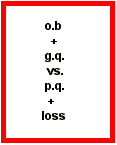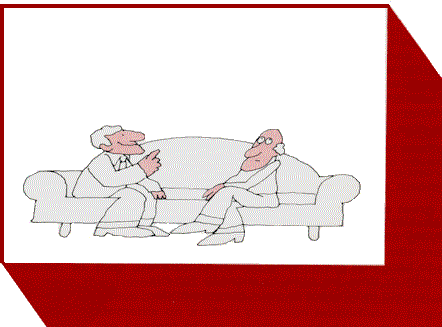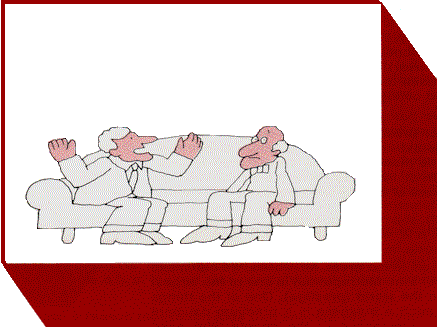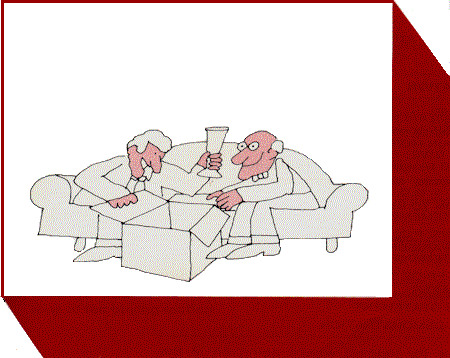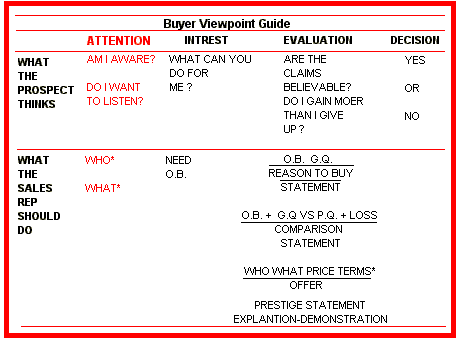|
No matter how proficient we may be in looking at things from the prospects' viewpoints, in determining their needs, in selecting the right o.b.'s, and in supporting them logically with g.q.'s, often we encounter another problem requiring just as much analytical thinking. This problem is competition. Many times sales representatives feel that it is to their advantage to compare their offering with that of competition. Of their own accord, therefore, they bring up this subject. This is salesmanship in its worst form. Let's examine why. If you have done a thorough lob of analyzing needs, of depicting them for the prospect, and of offering o.b.'s that satisfy these needs, your story will be both fundamentally sound and meaningful to the prospect. A comparison between your offering and competitive offerings will do nothing more to heighten the relevancy of that offering to the prospect. Furthermore, bringing up competition at this point can only work to your disadvanta9e. How can this be? First, the prospect may not even be thinking of competition and the mere mention of a competitor's name turns attention to it. Secondly, mention of a competitor by name often is taken as 'sour grapes" by the prospect. This is demeaning to you as a sales representative and certainly not in keeping with the professional service you have rendered up to this point. As a rule, therefore, sales representatives are encouraged not to bring up competition but to deal with it only when the prospect brings it up. When this happens try to set it aside and move back to the discussion of the prospect's needs, problems, and o.b.'s you can provide. This will usually overcome the prospect's objection and steer the presentation in the right direction. Often this is a sign that the prospect used the mention of competition as a means of testing you. If on the other hand the prospect insists on detailed information, the sales representatives' objectives should be to make comparisons that are favorable to their products, services or plans. TOP Making such a comparison involves use of the comparison statement motivation Idea. In order to use this motivation idea, it is necessary to add to your knowledge all possible information about your competitors and their offerings. Here's how to use this knowledge tactfully, and get the most power out of your comparison. We already have pointed out how in a well-planned and executed sales presentation the representative users the owner benefit and good quality motivation ideas. if the representative's product or service is made up of these ideas, then it is natural in a comparison of products or services that the competitor's product or service would have poor qualities (p.q.) resulting in loss. It is important to remember that poor quality (p.q.) and loss are the only two motivation ideas that do not apply to our product, service or pan and should only be used in a competitive situation. Just as it was important that you use the proper sequence of motivation ideas in an owner benefit-good quality situation, sequence is equally important in making comparison statements. The ideas in comparison statements should be presented in this order- owner benefit, good quality, poor quality, loss. Owner benefit must precede good quality to reduce chances and contrasts these with the limited benefits of the "package" of the prospect's thinking negatively about your own offering. Since the whore purpose of comparison is to persuade the prospect that possible loss may result from the use of your competitors! products, you gain the greatest impact by allowing the prospect to think naturally and visualize the loss. In other words, bring up the p.q. and help the prospect pro-loot the consequence (loss). This he or she will do almost without your help. Why is this so? First, the mind works four to seven times as fast as we can speak, so the prospect cannot help hut project ahead. Second, being inherently self-protective, the prospect will project a poor quality into a loss to himself or herself. Here is an example of how the comparison motivation idea works: "As you can see from our analysis, Mr. Jones, your insurance needs are several fold. However, you needn't concern yourself about these needs (o.b.). In the event of your premature death, Mrs. Jones will have the necessary income during the blackout period, (o.b.) and will be adequately provided for in her mature years (o.b.) under the provisions (g.q.} of the plan we've discussed. On the other hand, Mutual Funds are designed to accumulate capital with each share purchased, (p.q.) and in the event of premature death cannot provide the income Mrs. Jones requires (loss). How important is knowledge of the competitor's service? It could make or break the sale. Look at it this way. Suppose the competitor has a preconceived notion of what will appeal to a prospect (mortgage insurance). This competitor takes a "pack-age" approach to selling the product, i.e., he attempts to force feed a mortgage policy. Aware of this, the knowledgeable sales representative will have a pretty good idea of the o.b.'s the competitor is using. This representative, therefore, analyzes the prospect's total needs, offers appropriate o.b.'s and g.q.'s plan. The prospect wirl focus not only on the benefits of one plan vs. the inadequacies of the other, but in addition, he will attribute a uniqueness to the knowledgeable sales representative's plan that borders on exclusivity- The comparison statement, used properly, is an extremely powerful tool-one that can virtually neutralize competition-related obstacles. TOP Resolving doubt and uncertainty: Few prospects don't need insurance. This we know. However, far too few take the actions necessary to fill their needs. When a prospect says, "Your suggestion makes sense to me, but. well, not at this time," what is he or she telling you'? possibly that you have not crystallized the need in his or her mind. Earlier, in describing what need really means, we pointed out how critical it is in the interest step of the buying motion to identify specifically the prospect's needs before mentioning a single o.b., before supporting your o.b.s with g.q.'s, and before discussing any aspect of the offering motivation idea. The Life Insurance Company's Life Insurance Needs Analysis procedure helps you do this So you have an effective tool to use in identifying your prospect's needs. But, what else might the prospect who has made the above statement be telling you? Possibly that he or she is doubtful or uncertain either about the o.b.'s offered or about giving up whatever must be given up (time, money, effort) to acquire these o.b.'s. Is your plan worth its cost in time, money or effort? You have a reason motivation idea that enables you to respond to this situation effectively. It is called the prestige motivation idea and is defined as: A factual statement of accomplishment that builds the reputation of the Company and its people and/or enhances the value of its products and services. The purpose of this motivation idea is to resolve doubt and uncertainty or to put this more positively, win the confidence of the prospective Timing's important buyer. There are two kinds of prestige motivation ideas: ∑ The mention of a specific satisfied client or user (3rd party). ∑ The mention of a particular accomplishment of your Company, its products or personnel. Here is an example of the user prestige motivation idea. 'I can understand your hesitancy, Mr. Jones. This is a big decision for Life Insurance Needs Analysis. I work with many clients who have to make just such decisions. Two and a half years ago the Brown family (prestige user) was deliberating on a plan like this. Fortunately, they made the right decision at that time. Roth boys are attending good colleges today (o.b.) thanks to benefits provided by their plan." In our business, use of prestige user is to be carefully considered. Because of the extremely personal nature of our service to an individual, this motivation idea should only be used with express permission of the client-and then only when the client knows and approves of exactly what the sales representative intends to say. More than likely, the following kind of prestige motivation idea will be used: if the annual premium is too great, Mr. Jones, we can make special arrangements for that. The Life Insurance Company is one of the largest personal life insurers in the world (prestige). One of the things that's helped us build such a business is a premium payment plan tailored to the circumstances of the people who need insurance." Timing is important Prestige statements should be used only in the evaluation step of the buying motion.
Here's why... Let's say you gain favorable attention and then proceed to tell the prospect
about what you've done for another client.
This is a common mistake made by sales representatives in other businesses. Instead of reacting favorably, the prospect displays a complete lack of enthusiasm. Why the negative reaction? By presenting the prospect with testimonial o.b.'s, you jumped immediately into the evaluation step. You offered proof that someone had gotten a benefit but did not relate it to the needs of your prospect. Your prospect's viewpoint was not considered. Several things usually happen when this approach is used. First, interest is not stimulated and, therefore, there is no basis for positive evaluation. Second, the prospect may be embarrassed by the idea of 'keeping up with the Joneses." Remember, the one thing the prospect wants answered in the interest phase of the buying motion is, 'What's in this for me?" and not what has been done for someone else. Hold your prestige statements for the evaluation phase. Dealing with indifference: Indifference can be as great a deterrent to completing the sale as can doubt and uncertainty. Once again, if you have done an effective job of identifying needs, the odds that the prospect will remain indifferent are slim. Occasionally, however, if a prspect has been trusting to luck that his earning power will grow sufficiently so that he will in time be able to provide for his family's needs, he may remain indifferent to your recommendations. There is another reason motivation idea you can use to handle such situations.
It is called the explanation-demonstration motivation idea (ex-demo.) and is
defined as descriptive and explanatory ideas expressed in words, pictures, and actions
that increase the understanding and motivation of previously used motivation ideas. The following examples convey the persuasive power of the ex-demo. Idea. Salesman's response without ex-demo. motivation idea: "Mr. Doolittle, you can forget about damage to your fragile instruments (o.b.) when you ship in our super-cushion corrugated cartons (g.q.). The design of these cartons is unique (g.q.). and only top quality materials are used (g.q.)," etc.
vs. Salesman's response with ex-demo. motivation idea: "Mr. Doolittle, you can forget about damage to your fragile instruments (o.b.) when you ship in our cartons. Watch this." Salesman slams one of his sealed cartons to the floor several times. He then opens the carton (ex-demo.) and says, "Crystal grass ware, as delicate as your instruments, in perfect shape, Mr. Doolittle. This complete protection (o.b.) is provided by the cushion design corrugated walls (g.q.)."
In the first approach, the salesman was relying entirely on the spoken word to convince the buyer. In the second approach the salesman combined showing and telling to make the o.b.'s and g.q.'s more vivid and real in the mind of the buyer. He capitalized on the power of the ex-demo. motivation idea. In our business the ex-demo. motivation idea might be used as follows: "I certainly hope your earning power increases in accordance with your projections, Mr. Smith. This is essential to the wellbeing of your family. "In your interest, however1 you might want to consider the findings of the U.S. Department of Commerce." Sales representative takes study from briefcase and refers to chart on income from all sources at age 65 (ex-demo.). "As you can see from this chart, 66 out of 100 men had $5,000 or less income at the age of 65. To make sure you are not among the 66 percent who Tailed to plan, (o.b.) you should fake advantage of this plan (g.q.) now." Sales aids add impact Studies, flip-charts, diagrams, and other printed visuals are important tools to be used in conjunction with the ex-demo. motivation idea. However, as they are commonly used, visual aids usually do more harm than good. How
many times have you observed a sales representative opening a presentation book to a part
showing several statements on a chart and then immediately begin In this way you will not compote for your prospect's attention with an item that is supposed to aid you. In addition, you should not put the prospect in the evaluation stage before the individual knows what is to be evaluated. Good judgment is of great importance in the selection and use of sales aids. Use what you need to explain and demonstrate the product, service or plan you are selling and/or to promote the prestige of your organization. At this point in our effort to describe motivation ideas that enable a sales representative to lead the prospect's mind through the buying motion, we've introduced new terms (o.b., g.q., offering, comparison statement, prestige, ex-demo.) into our sales vocabulary. The concept behind each of these terms provides a fundamentally sound means of dealing with the reason-related situations that crop up when a prospect is contemplating purchase or when he or she is confronted with an offer to buy. The terms merely put "handles" on our motivation ideas. You might say they "codify" them. Since timing-using the right motivation ideas at the right time-is so important, we've reconstructed these ideas under the Buyer Viewpoint Guide.
The sales representative who uses this guide as a road map in all personal serling activity wirl never have to ask, "Where do I stand with my prospect and what must I do next?" He or she will have a sound basis for judging what's going on in the prospect's mind and for knowing which motivation ideas to use next. Summary-Handling competition:the I. As a rule, sales representatives are encouraged not to bring up competition, but to deal with it only when the prospect brings it up. II. Know all you can about your competitor's product before you make a comparison statement. III. Poor quality and loss are the only two motivation ideas that do not apply to your offering and should be used only in a competitive situation. IV. Allow the prospect to think naturally and visualize a loss from the competitive product. TOP Summary-Resolving doubt and uncertainty: I. The prestige motivation idea enables you to answer the prospect's question, "Is your plan worth the cost to me in time, money and effort?" II. It is defined as: a factual statement of accomplishment that builds the reputation of your Company and its people, products and services. Ill. There are two kinds of prestige motivation ideas: A. The mention of a specific satisfied client or user. B. The mention of a particular accomplishment of your Company, its products or personnel. IV. Prestige statements should be used only in the evaluation step of the buying motion. Summary-Dealing with indifference: I. If you have done an effective lob of identifying needs, the odds that the prospect will remain indifferent are slim. II. The ex-demo. motivation idea is the use of descriptive and explanatory ideas-expressed in words, pictures and actions to increase understanding and motivation. III. Visual aids are effective tools, but should be used only to highlight or further explain ideas which the sales representative has already stated. What can I do to improve? TOP |

